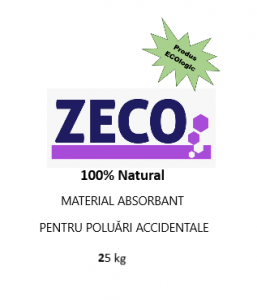Environment protection
Any decomposition process results in toxic substances that are scattered in the air generating less or greater pollution, some even emitting unpleasant odors that can spread on extremely large surfaces.
In order to comply with environmental requirements and, last but not least, in order to eliminate or substantially reduce the unpleasant effects on the population in the surrounding areas, any industrial park, purification plant, landfill or even livestock farm must make a difference higher air quality.
Our company produces zeolite activated by specific processes that prove to be highly effective in leachate uptake and inhibition of unpleasant smell resulting from the decomposition of organic waste.
Also Activated Zeolite can be used to thicken the sludge from the treatment plants having a double role: inhibiting the unpleasant odor emitted by it and significantly increasing the quality of the sludge, whether its subsequent use will be biogas production or direct bioremediation.
The use of zeolite in the bioremediation of polluted soils is extremely beneficial because it has a special, natural absorption affinity for environmentally harmful elements but also because they are used together with microorganisms specific to their consumption favoring their multiplication in the internal zeolite structure and on the surface It also helps maintain the oxygen-carbon-nitrogen balance, implicitly a better aeration of the soil.
Rupea zeolite can also be used to speed up the decomposition of organic waste. Stored in a special compost pit, Zeolite can be applied as intermediate layers between the layers of rubbish hurrying the decomposition and enrichment of the quality of the resulting compost, but also the soil in which it is then placed by increasing the water retention capacity, soil aeration, the ability to retain nutrients.
Rupea zeolite is an industrial hydrocarbon absorber and its derivatives. Our tests, together with specialized institutions, show that our zeolite has a high hydrocarbon absorption capacity by permanently retaining it in its reticular structure until it is eliminated by the biodegradation action.
In other respects, in enterprises where it is possible for the material resulting from the absorption of hydrocarbons in the zeolite's cross-linking structure to be introduced into a combustion furnace, it will emit a very high calorific power precisely because of this internal zeolite porosity.
Natural zeolites are used in the treatment of waste water in the chemical, pharmaceutical, food, metallurgical, and urban wastewater treatment.
Residual waters of different origin and with different impurities, contain organic pollutants and inorganic salts with interchangeable cations: NH4 +, Cu2 +, Pb2 +, Zn2 +, Cd2 +, Cr2 + etc.
The problem of removal or reduction of ammonia concentration in wastewater is closely related to maintaining ecological balance. The special selectivity of natural zeolites of the clinoptilolithic type for ammonium ion allowed them to be used in the process of purifying waste water containing ammonia.
In many countries, experiments on zeolite volcanic tuffs have taken place to contain cations of heavy metals from solutions.
Clinoptilolite is recommended for the treatment of waste water in order to retain lead, copper, cadmium, chromium, zinc, manganese and iron cations.
Clinoptilolite is used for the treatment of urban waste water for the removal of organic substances and phosphates. Tests conducted on a pilot plant indicated a phosphate removal of about 80% and an organic load of about 22%.
Clinoptilolite can be used to treat waste water containing chlorinated organic compounds. They can be retained at a rate of 73%.
The use of natural zeolites in waste water scavenging technologies in the form of sustained hydrolysed coagulants is a novelty. The research has as main objective the superior economic valorisation of the zeolite through the creation of finished products with high commercial potential through non-polluting technologies, easy to use in hydrocarbon-treated water treatment ... The results of the tests revealed an improved treatment efficiency in the comparative with agents such as Ferric Chloride.
Activated zeolite is used to purify waste water containing toxic chlorinated organic compounds (dichloroethylene, trichlorethylene, chloroform, dichloroethane, etc.). They also have a high adsorption capacity of non-polar chlorinated compounds from aqueous solutions as well as benzene, toluene, xylene from contaminated water.
The development of nuclear research and multiple applications of radioactive isotopes have posed a number of problems in the field of waste water treatment containing radioactive substances.
Natural zeolite has been widely used in the field of waste water treatment containing radioactive isotopes: 134Cs +, 137Cs +, 90Sr2 +, Th4 +, U6 +. Once saturated with Cesium, clinoptilolite can be stored for a long time under optimum conditions for radioactivity. Cesium from such stocks can be chemically recovered, in which case clinoptilolite can be considered as reusable.
Through repeated researches and experiments, it has been demonstrated that by adding Zeolite to solutions contaminated with the Strontium radioactive isotope (90Sr), the degree of pollution and the takeover of this harmful element by plants is significantly reduced. In this way zeolite can constitute and become an important factor in limiting and combating the polluting effects of "radioactive pollution" on crops or pastures.
Radionuclide containment capacity or radioactive decontamination using zeolite volcanic tuffs is the result of their intrinsic properties, the most prominent of which are: the radionuclide adsorption capacity of the solutions, the ion exchange capacity, the selective nature of this exchange, and the resistance to radiation degradation .
Depending on the characteristics of filters that are included in the air filtration equipment, Rupea zeolite can be used to remove sulfur dioxide (SO2) from air, remove ammonium and hydrogen sulfide from the contaminated air of refineries or other factories generates such substances in the atmosphere, eliminates volatile organic carbon compounds (VOCs), transforming them into hydrophobic carbon, absorbs airborne radiation.
The zeolite study is far from complete. Many institutions, organizations and companies around the world are conducting research, tests, and studies to discover new properties and uses of this miraculous natural rock volcanic rock over millions and millions of years.
Products
Material absorbant pentru
poluări accidentale




